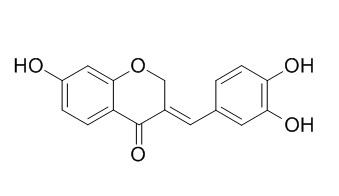Sappanone A
Sappanone A is the first homoisoflavanone to be discovered with melanogenesis inhibitory activity. It exerts its anti-inflammatory effect by modulating the Nrf2 and NF-κB pathways, and may be a valuable compound to prevent or treat inflammatory diseases.
Inquire / Order:
manager@chemfaces.com
Technical Inquiries:
service@chemfaces.com
Tel:
+86-27-84237783
Fax:
+86-27-84254680
Address:
1 Building, No. 83, CheCheng Rd., Wuhan Economic and Technological Development Zone, Wuhan, Hubei 430056, PRC
Providing storage is as stated on the product vial and the vial is kept tightly sealed, the product can be stored for up to
24 months(2-8C).
Wherever possible, you should prepare and use solutions on the same day. However, if you need to make up stock solutions in advance, we recommend that you store the solution as aliquots in tightly sealed vials at -20C. Generally, these will be useable for up to two weeks. Before use, and prior to opening the vial we recommend that you allow your product to equilibrate to room temperature for at least 1 hour.
Need more advice on solubility, usage and handling? Please email to: service@chemfaces.com
The packaging of the product may have turned upside down during transportation, resulting in the natural compounds adhering to the neck or cap of the vial. take the vial out of its packaging and gently shake to let the compounds fall to the bottom of the vial. for liquid products, centrifuge at 200-500 RPM to gather the liquid at the bottom of the vial. try to avoid loss or contamination during handling.
Arch Biochem Biophys.2024, 759:110111.
J of l. Chroma.&Related Tech2020, 43(11-12):414-423.
Nutrients2020, 12(2):488
Development.2024, 151(20):dev202518.
Evid Based Complement Alternat Med.2018, 2018:4259603
Phytother Res.2022, 10.1002:ptr.7592.
Food Chem Toxicol.2024, 186:114589.
Molecules.2019, 24(21):E3834
Arch Toxicol.2017, 91(10):3225-3245
J Cell Mol Med.2023, 27(10):1423-1435.
Related and Featured Products
Int J Mol Sci. 2012;13(8):10359-67.
Melanogenesis Inhibition by Homoisoflavavone Sappanone A from Caesalpinia sappan.[Pubmed:
22949866]
METHODS AND RESULTS:
Homoisoflavanone, Sappanone A, was isolated from Caesalpinia sappan and proven to dose-dependently inhibit both melanogenesis and cellular tyrosinase activity via repressing tyrosinase gene expression in mouse B16 melanoma cells. To our knowledge, Sappanone A is the first homoisoflavanone to be discovered with melanogenesis inhibitory activity.
CONCLUSIONS:
Our results give a new impetus to the future search for other homoisoflavanone melanogenesis inhibitors.
Int Immunopharmacol. 2015 Jun 26;28(1):328-336.
Sappanone A exhibits anti-inflammatory effects via modulation of Nrf2 and NF-κB.[Pubmed:
26122134]
Homoisoflavonoids constitute a small class of natural products.
METHODS AND RESULTS:
In the present study, we investigated the anti-inflammatory effect of Sappanone A (SPNA), a homoisoflavanone that is isolated from the heartwood of Caesalpinia sappan (Leguminosae), in murine macrophages. SPNA inhibited the production of nitric oxide (NO), prostaglandin E2 (PGE2) and interleukin-6 (IL-6) as well as the expression of inducible nitric oxide synthase (iNOS), cyclooxygenase-2 (COX-2) and IL-6 in lipopolysaccharide (LPS)-stimulated RAW264.7 cells. Moreover, SPNA protected C57BL/6 mice from LPS-induced mortality. Treatment of RAW264.7 cells with SPNA induced heme oxygenase (HO)-1 protein and mRNA expression and increased nuclear translocation of the nuclear factor-E2-related factor 2 (Nrf2) as well as the expression of Nrf2 target genes such as
NAD(P)H:quinone oxidoreductase 1 (NQO1). Knockdown of Nrf2 by siRNA blocked SPNA-mediated HO-1 induction. SB203580, p38 mitogen-activated protein kinase (MAPK) inhibitor, blocked SPNA-induced HO-1 expression and nuclear translocation of Nrf2, suggesting that SPNA induces HO-1 expression by activating Nrf2 through the p38 MAPK pathway. Consistent with the notion that the Nrf2/HO-1 pathway has anti-inflammatory properties, inhibiting HO-1 significantly abrogated the anti-inflammatory effects of SPNA in LPS-stimulated RAW264.7 cells. Moreover, SPNA suppressed LPS-induced nuclear factor κB (NF-κB) activation via inhibiting Ser 536 phosphorylation and transcriptional activity of RelA/p65 subunit of NF-κB.
CONCLUSIONS:
Taken together, these findings suggest that SPNA exerts its anti-inflammatory effect by modulating the Nrf2 and NF-κB pathways, and may be a valuable compound to prevent or treat inflammatory diseases.



